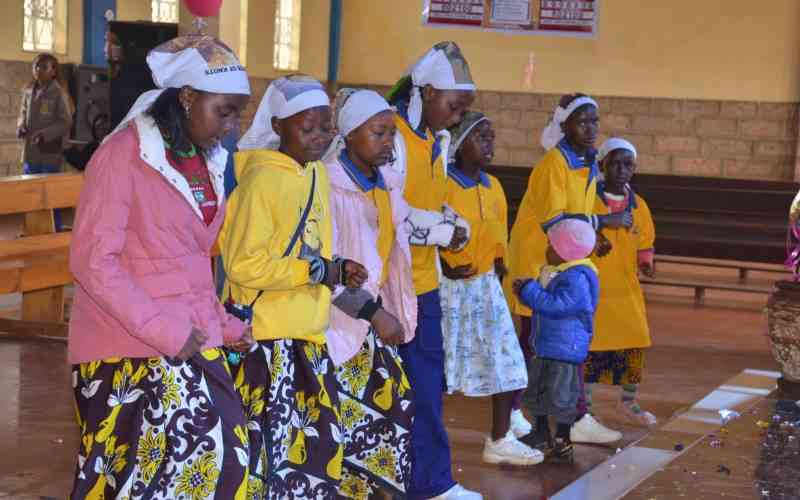
Idi Amin (right) lived in the house when was deployed to Kiamacibi village in Mathira constituency to fight the Mau Mau. [Courtesy]
Whenever a mention of Idi Amin Dada’s name is made in the interior Kiamacibi village of Mathira constituency, locals in their sunset years tremble.
They remember with nostalgia how the Ugandan soldier, who later became president, maimed and killed their colleagues, who were members of the outlawed Mau Mau uprising.
He was serving as a senior military officer under the British colonial army and had been deployed in the village due to heightened activities against the colonial masters as locals agitated for freedom.
Wambui Muriuki, 84, was a young girl in 1954, when Amin was deployed in the area, which at that time covered the larger Nyeri and Kirinyaga region.
Muriuki recalls the untold suffering that she went through under the hands of the military officer, who used to be escorted by a battalion of soldiers numbering close to over 200 men. One day, Amin and his army descended on the village, and Muriuki run for her dear life.
Unfortunately, she stumbled and a piece of stick got lodged in her left leg. To date, the stick is still in her flesh and serves as the best reminder of Amin’s cruelty.

Wambui Muriuki, 84, claims she was a victim of Idi Amini's punitive expedition in 1954. [Courtesy]
“Amin was harsh and if he got wind that there were members of Mau May in any village, he used to rush in the area accompanied by a convoy of vehicles and could beat us hard. We feared him since he killed so many people, who were buried in a ditch still in our area,” Muriuki said.
Muriuki adds that the military officer was assisted by his deputy, whom they only knew as YY, a white officer notorious for caning locals using a whip (Nyahunyo).
“My left shoulder pains to date as a result of the whipping by YY. Our village was a living hell as he tried to please Amin, who served the colonial masters with loyalty and cruelty,” the granny recalled.
She said in one of his punitive expeditions, Amin shot one of the Mau Mau generals known as Waruhiu Itote or popularly as General China, who luckily survived and is believed to have been bought into the side of the colonialists.
Itote would rise during the Kenyatta era and was commandant of the National Youth Service.
Another victim of Amin’s cruelty is 94-year-old Njogu Ruheni. He narrated how there was strict coordination between the home guards and the top-notch colonial officers and how many were suppressed for being associated with Mau Mau activities.
“We were subjected to torture and intimidation by Amin and his men but even after our people were buried in mass graves, we emerged victorious and got independence,” Ruheni added.

Njogu Ruheni, 94, claims he is a victim of Amin’s cruelty. [Courtesy]
Amin’s living quarters and other structures that served as his office and cells still stands at the current Kiamacibi Police Station.
“The four-bedroomed wood walled house is at the verge of collapse and needs preservation, it should be gazetted and equipped with artefacts used by Mau Mau in a bid to fight the colonial masters to inform the younger generation,” Muriuki said.
The house is currently used by the officer commanding station (OCS) as her living quarters.
Its walls have timbers horizontally overlaying each other unlike in modern structures where timbers usually run vertically.
The four-bedroom main house has a sheltered pavement joining it to a smaller, one-roomed detached kitchen of matching workmanship.
The locals want the National Museum of Kenya (NMK) to consider the gazettment of the house as a national monument so that generations may visit the area to understand where the country came from.
“Unless it is preserved and maintained, the structure may fall at any given time, we want the relevant authority to move with speed,” Peter Kinyua, a local said.
Nyeri National Museums Nyeri curator, Charles Aongo, said they have initiated the process of gazetting the site as a national monument, which will act as a hub for the history of the country.

Idi Amin Dada. [Courtesy]
“We have received requests from the community and I have forwarded the issue to the relevant offices. In Nyeri alone, we have over 100 gazetted sites,” Aongo added.
Another reminder that rekindles the memory of Amin at Kiamacibi is the many children that he sired with local women.
“Amin’s footprints are visible thanks to his grandchildren who are tall, stout and of dark complexion just like Amin. Although they do not like being associated with their father or the grandfather for the third generation, they possess many of his attributes,” a local said.
After Kenya gained independence, Amin who had joined the Kings African Rifles (KAR) of the British Colonial Army starting as a cook in 1946 went back to his country and was absorbed by the Ugandan army as a senior officer.
 The Standard Group Plc is a multi-media organization with investments in media platforms spanning newspaper print
operations, television, radio broadcasting, digital and online services. The Standard Group is recognized as a
leading multi-media house in Kenya with a key influence in matters of national and international interest.
The Standard Group Plc is a multi-media organization with investments in media platforms spanning newspaper print
operations, television, radio broadcasting, digital and online services. The Standard Group is recognized as a
leading multi-media house in Kenya with a key influence in matters of national and international interest.











